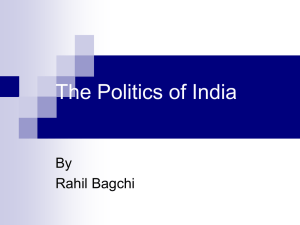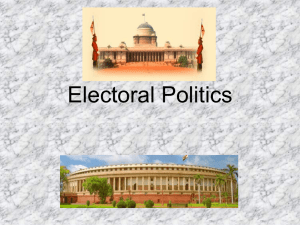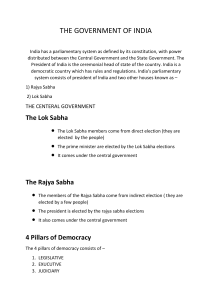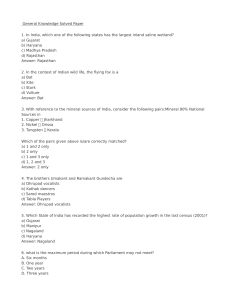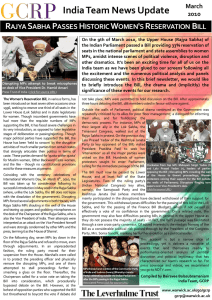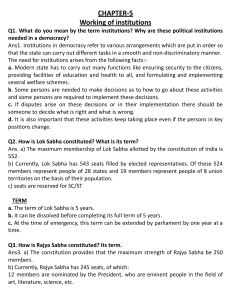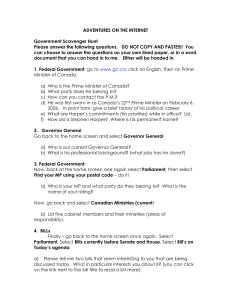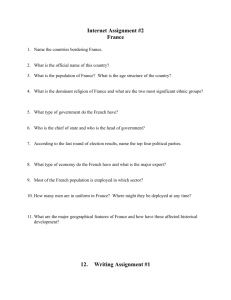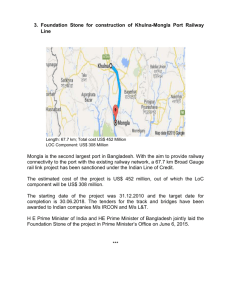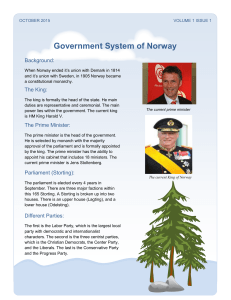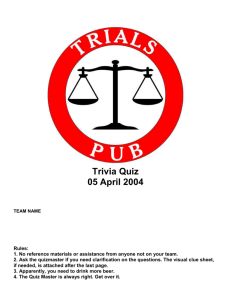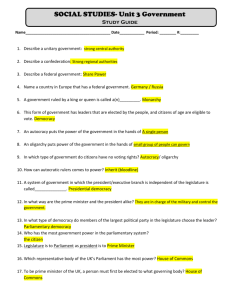Politics of India
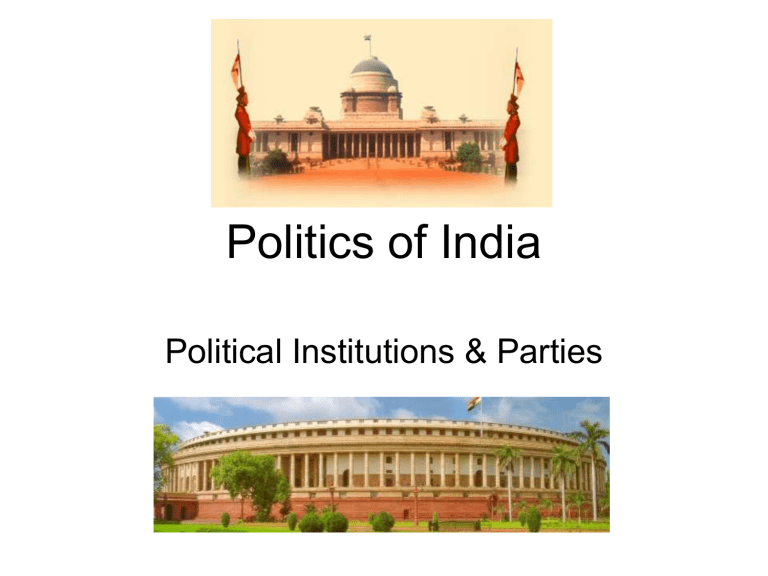
Politics of India
Political Institutions & Parties
Republic of India
• A federal republic with a parliamentary system of government
• capital: New Delhi
A federal system
• 26 states and 6 centrally administered
Union Territories
– 2 states are partially claimed by Pakistan and
China
Federal system
• Relatively centralized
• federal government controls the most essential government functions
– defense
– foreign policy
– taxation
– public expenditures
– economic (industrial) planning
Federal system
• state governments formally control
– agriculture
– education
– law and order within states
– dependent on central government for funds
Federal system
• Balance of power between central and state governments
– varies by time and place
– state power was constrained
• during the rule of Nehru and Indira Gandhi
– state governments have more room to maneuver
• when central government is weak
• since 1998
Federal system
• considerable center-state conflict when ruling political party in a state is different from national ruling party
Parallel state structure
• Formal political structure of the states parallels that of the national government
• national
• President state
Governor
• Prime Minister Chief Minister
• Parliament Assembly
• Supreme Court High Court
The legislature
• Parliamentary system of government
– the executive authority is responsible to the
Parliament
The legislature
• bicameral Parliament
– Rajya Sabha (Council of States)
– Lok Sabha (House of the People)
Rajya Sabha (Council of States)
• The Upper House
Upper House
• Rajya Sabha (Council of States)
• not more than 250 members
– 12 are nominated by the President of India
– the rest are indirectly elected
• by state Legislative Assemblies
• The Council of States can not be dissolved
– members have terms of 6 years
– 1/3 members retire at end of every 2nd year
• House of the
People
Lok Sabha
Lower House
• Lok Sabha (House of the People)
• 545 members
– 2 are appointed by the President of India
– the rest are directly elected from singlemember districts
• 5-year terms unless dissolved
• Lok Sabha elects its presiding officer
– the Speaker
Lok Sabha
• Elections held at least every 5 years
• Prime Minister may call elections earlier
• 543 single-member districts of roughly equal population
• party nomination
• 1st-past-the-post
– winner-take-all
• women’s share
Elections to Lok Sabha
• Vote share of 3 major political parties
Current composition
• 43 parties in the 13th Lok Sabha (1999)
• 39 parties in the 14th Lok Sabha (2004)
• Bharatiya Janata Party (BJP) 184 138
• Indian National Congress (INC) 109 145
• Communist Party of India (M) 34 43
• other political parties 218 217
• total 545 543
Indian National Congress
• India’s oldest political party
– since 1885
• India’s premier political party
– until 1990s
• in 1960s many regional parties started challenging INC’s monopoly on power
Indian National Congress
• Indira Gandhi
– created a top-down structure
– party leaders appoint party officials
– some limited party elections
• left-of-center, pro-poor political platform
Indian National Congress
• INC moved toward the ideological center
– Beginning in 1984
• INC today tilts right-of-center
– economic efficiency
– business interests
– limited government spending
Indian National Congress
• INC has always attracted support from diverse social groups
• in the 1990s INC has lost some of its traditional constituencies among the poor and Muslims
Bharatiya Janata Party (BJP)
• The major political party in India today
• right-leaning, Hindu-nationalist party
– first major party to mobilize explicitly on the basis of religious identity
Bharatiya Janata Party (BJP)
• better organized than INC
– disciplined party members
– carefully selected party cadres
– clear and respected authority line within the party
Bharatiya Janata Party (BJP)
• Traditional supporters
– urban, lower-middle-class groups
• base of support widened since mid-1980s
– Hindu nationalism
– north-central India
– decline of Indian National Congress
– Muslims as convenient scapegoat for frustration
BJP’s rapid rise to power
• electoral success from 1989 to 1999
– difficulty in forming alliance with other parties
• break with past traditions
– relatively moderate, centrist position
• BJP formed governing coalition in 1998
– collapsed in 1999
• BJP formed a new coalition in 1999
– more broadly based than previous coalition
Bharatiya Janata Party (BJP)
• economic liberalization and stability
• privilege the interests of the Hindu majority
Prime Minister
• Leader of the majority party leader in Lok
Sabha becomes the prime minister
• prime minister nominates a cabinet
– members of Parliament in the ruling coalition
– Council of Ministers
• effective power is concentrated in the office of the prime minister
– where most of the important policies originate
Prime Ministers of India
• 38 years in the Nehru-Gandhi family
• more and more rapid turnover
The President of India
• Head of the State
• Commander-in-Chief of the armed forces
• elected by an electoral college
– national Parliament
– state legislature
• 5-year terms
• can be reelected
The President of India
• Ceremonial office
– symbolize national unity
– supposedly above partisan politics
• mostly acts on the advice of the prime minister
• President plays a significant role when the selection of a prime minister is complex
– in 1998 President requested BJP to form govt.
The Judiciary
• Fundamental contradiction in constitution
– principle of parliamentary sovereignty
– principle of judicial review
The Judiciary
• judiciary tries to preserve the constitution’s basic structure
• to ensure that legislation conforms with the intent of the constitution
• parliament tries to assert its right to amend the constitution
